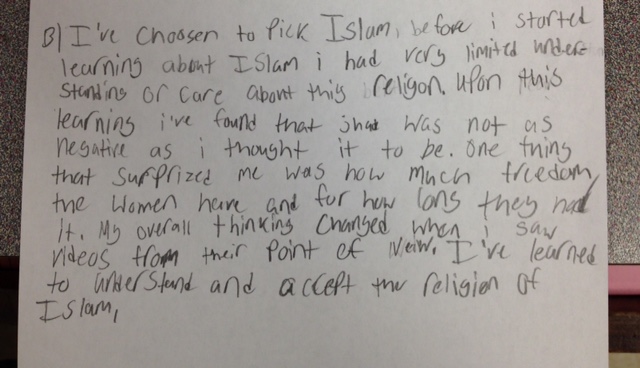I know…it’s been forever since I’ve written. Spring break and lots of life have gotten in the way, and I apologize.
Class, however, has been marching on. We have made it through our Christianity unit, which always feels like a challenge to me. It’s challenging because there are always a few students who have been raised on the Bible and know its passages far better than I do. It’s also challenging because it’s one of those religions that students think they know everything about before we get started. And because trying to expand students’ notions of Christianity (or expose them to divisions within it) can push some buttons for the firm believers in my classroom in a way that investigating a religion that they are less attached to does not.
As a result, while I do spend some time reviewing the core beliefs of Christianity and analyzing passages from the New Testament (I especially like the Sermon on the Mount for the way it helps differentiate between “old ways” and Jesus’s teachings), I allocate most of the unit to understanding the historical development of the religion (helped by useful Eduportal videos like this one) and looking at its diversity. It’s my hope that students end the unit with the firm grasp of the concepts that all Christians share, but an understanding that all Christians are not like the ones they know.
I have a couple of strategies for doing this. We spend a few days looking at Mormons, and I ask the students to answer for themselves the question of whether Mormons are Christian or not. The Church of Jesus Christ of the Latter-Day Saints says, unequivocally, yes. (See the most recent shift in their logo, below).
 to
to
 But others question if a group that adds new books to the Christian canon can truly fit in. I have found the PBS video on the Mormons to be an excellent supplement here, and a more sober approach than the South Park episodes and broadway musicals that my students tend to be more familar with.
But others question if a group that adds new books to the Christian canon can truly fit in. I have found the PBS video on the Mormons to be an excellent supplement here, and a more sober approach than the South Park episodes and broadway musicals that my students tend to be more familar with.
We also spend some time looking at other Christian groups: the Amish, Christan Scientists, Quakers, Christadelphians, and more. Again, we focus on the defining beliefs of Christians: monotheism, belief in Jesus as a savior, an emphasis on love, forgiveness, hope, and grace, and the practices of baptism and communion. Then I ask students to consider what makes each group different and unique.
We ended the unit with a sort of transitional field trip–a trip to a mosque and a church. This year we visited Jaamat Ibad Ar-Rahman and Resurrection United Methodist Church. Chosen both for proximity, their welcoming attitude, and the variety of experiences they provide, I found this year’s pairing to work especially well. Jaamat Ibad Ar-Rahman is in a small, low building that was clearly never intended to be a mosque. In fact, it shares a parking lot with a store-front church. For many of my students, this is a different kind of religious building than they have been to, in that there is absolutely no fancy architecture–the emphasis is solely on the creation of a community space for worship and study. The students were shown to the library and listened to a presentation by a member of the congregation. This was interesting too–the imam, Mowlid Ali, is very young, somewhat quiet, and had to leave early to lead Friday prayers in a neighboring city. His colleague was an older gentleman who was very chatty and eager to share his understanding of Islam. The contrast between the two men was almost comical–but again I appreciate that the students had an opportunity to hear from two voices.
Following that, we visited the church where Reverend Alan Felton shared with the students about Methodism, a denomination we had not encountererd yet. I thought the kids were fading a little–we had arrived late and lunch was waiting–but was impressed by how they perked up with questions about the Eucharist and the little ways in which the ceremony differed from some of their own experiences. It was clear as they asked about the things that they saw that they were building a comparison in their heads.
It was a fitting and pleasant end to a unit that I always have a little trepidation about teaching. Today, on the way in to work, I heard a piece on NPR that helped me articulate my approach to teaching this section on Christianity, and really to how I hope to approach much of my teachings. The snippet was about Archbishop Michael Fitzgerald, a Catholic who has been teaching about Islam to students in both Catholic and Muslim universities. He states at one point, when addressing a room of devout Muslims: “I said to the students ‘I’m not here to teach you anything — I’m here to help you to learn, and to understand your own religion better.” Like Fitzgerald (although I am sure his expertise in the field of religious studies is far far greater than mine), I recognize that it does me no good to try to teach my students what they may already know, but rather to lead them to questions and ideas they may not have encountered yet, to give them opportunities for new experiences, and tools for engaging with them. Hopefully, with this unit, I did at least a little of that.




